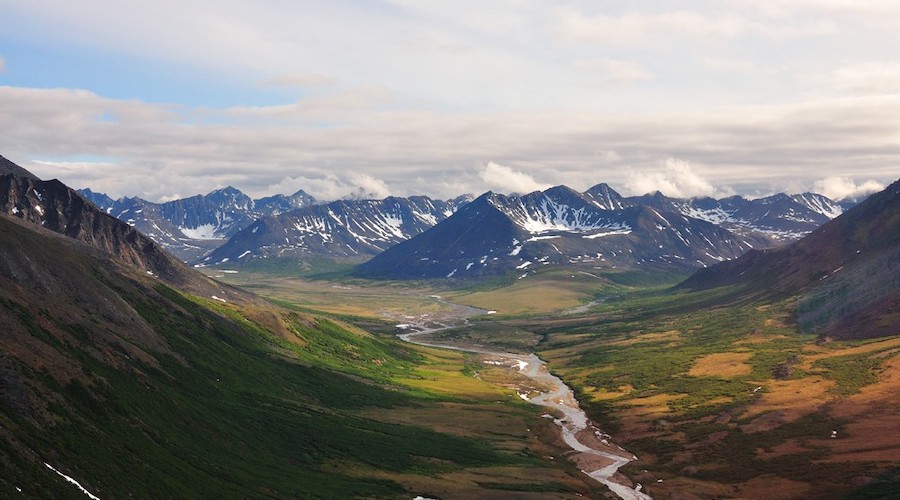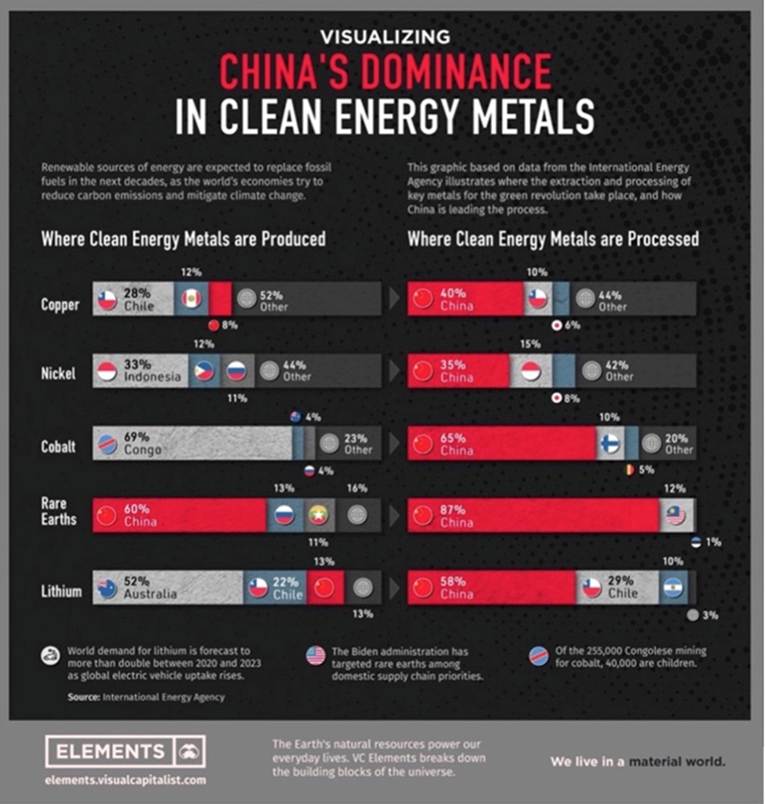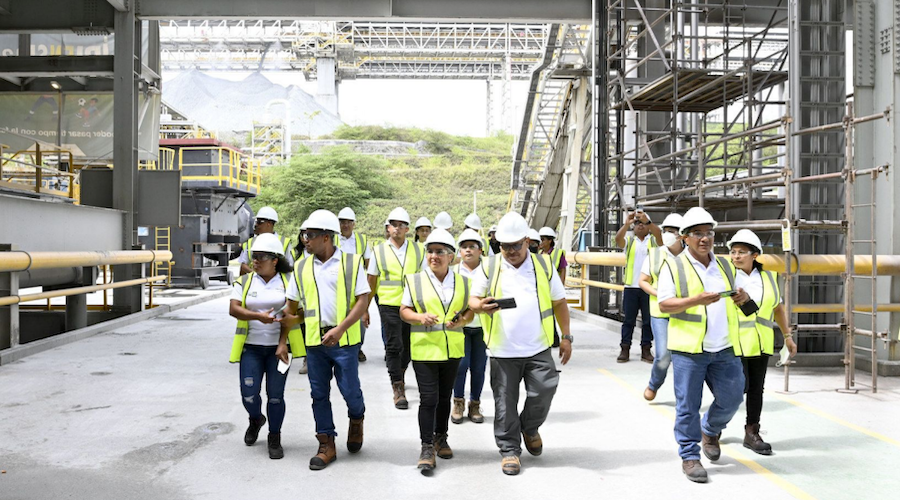The stars are aligning for Graphite One

When Biden was president, he invoked the Defense Production Act to encourage domestic production of critical minerals. Battery materials such as lithium, nickel, graphite, cobalt and manganese were added to the list of items covered under the act — a 1950s law that former President Harry Truman enlisted to ramp up steel production for the Korean War — to help companies access $750 million in funds.
Trump used the law in his first term to spur mask production during the coronavirus pandemic.
Now, Trump is again tapping the Defense Production Act, this time as part of an effort to provide financing, loans and other investment support to domestically process critical minerals and rare earth elements, according to a White House official, via Bloomberg.
Funding will be provided through the US International Development Finance Corporation, working with the Department of Defense.
An executive order signed on Thursday, March 20th by the president invokes emergency powers to boost the ability of the US to produce critical minerals. The idea is to facilitate domestic natural resource extraction to make the country less reliant on foreign imports.
China’s grip on critical minerals
The administration says the US is import-reliant on at least 15 critical minerals and that 70% of imports of rare earths come from China.
Included on the US Geological Survey’s list of 35 critical minerals are the building blocks of the new electrified economy, including lithium and graphite. China has a stranglehold on processing both metals, meaning it can weaponize them during conflicts with its adversaries, as it has done before with Japan (rare earths), and the United States with export controls on gallium, germanium, graphite, antimony. In December 2023 China banned the export of technology to make rare earth magnets.
Indeed, when it comes to raw materials for the electric vehicle industry, China is undisputedly the most dominant force on the planet.
For decades, China has dominated critical minerals, with Canada and the US, among other nations, all too willing to let Beijing do the mining and/ or processing and sell the end-products, such as rare earth magnets, lithium batteries and battery-grade graphite, back to us. Even now, rare earths extracted at MP Materials’ California mine are sent to China for processing.
Almost every metal used in EV batteries today comes from there, either mined or processed. Thanks to its technological prowess in refining, China has established itself as the across-the-board leader in the battery metals processing business.

Fighting back
In response to China’s dominance over critical minerals, the executive order encourages faster permitting for mining and processing projects and a directive for the Interior Department to prioritize mineral production on federal land.
It should be noted that Trump has always supported domestic production of critical minerals; his beef has been with electric vehicles and the billions worth of subsidies doled out for them during the Biden administration. According to a White House Fact Sheet:
- In 2017, President Trump implemented a federal strategy to ensure secure and reliable supplies of critical minerals.
- In 2019, President Trump signed five presidential determinations finding that domestic production of rare earth elements and materials is essential to the national defense.
- In 2020, President Trump declared a national emergency to expand the domestic mining industry, support mining jobs, alleviate unnecessary permitting delays, and reduce the nation’s dependence on China for critical minerals.
The administration says it will coordinate with the private sector to ensure a stable and resilient domestic supply chain for critical minerals, which under the executive order includes uranium, copper, potash, gold, as well as any other element, compound, or material as determined by the chair of the National Energy Dominance Council, reports Bloomberg.
Graphite One
Graphite One (TSXV:GPH, OTCQX:GPHOF) has received strong support from the US government for developing its “made in America” graphite supply chain anchored by Graphite Creek in Alaska, the largest graphite deposit in the country and one of the biggest in the world.
Graphite One plans to develop a “circular economy” for graphite. Its supply chain strategy involves mining, manufacturing and recycling, all done domestically — a US first.
Regarding Trump’s March 20 executive order, Graphite One said it welcomes the EO, titled “Immediate Measures to Increase American Mineral Production.”
“This new Critical Minerals Executive Order serves as the strongest signal yet that the U.S. Government has not only recognized the national security need for critical minerals including graphite, but that there will now be a ‘whole of government’ engagement to accelerate domestic development,” Graphite One’s CEO Anthony Huston said.
“The new authorities provided via the Defense Production Act, the EXIM Bank, and the FAST-41 transparency-in-permitting process — all of which have recognized the importance of Graphite One’s complete supply chain strategy — confirm that G1 is well positioned for this new focus on bringing projects into production.”
The EO tasks the secretaries of defense, energy and interior with actions requiring responses within 10, 15, 30 and 45 days, and waives related legal requirements under the “national emergency” provision of the Defense Production Act (DPA).
Graphite One has already received a DPA grant to accelerate the company’s Feasibility Study, which is expected to be released in April. G1 has also received a $325 million non-binding Letter of Interest from the EXIM Bank for the construction of the company’s Ohio-based anode manufacturing plant. Both DPA and EXIM are among the agencies that will have expanded critical mineral authorities under the new EO.
G1 expects to submit a formal application to EXIM in 2025.
The full text of the executive order can be found here, on the presidential actions page of the White House website.
The Critical Minerals EO follows three executive orders issued by President Trump on his first day in office: “Declaring a National Energy Emergency,” “Unleashing American Energy,” and “Unleashing Alaska’s Extraordinary Resource Potential” referenced in the Jan. 23 Graphite One press release.
The new EO aligns with the focus on Alaska’s role in US resource development, hosting 49 of the 50 US government-designated critical minerals. As Alaska Governor Mike Dunleavy noted in his 2025 State of the State address, “the Graphite One deposit, the largest in North America, north of Nome, continues to move ahead with support from a Defense Department grant. Subject to securing project financing, construction could begin by 2027 and the mine could be producing as early as 2029.”
More good news regarding political backing for Graphite One came this week from the office of the Department of the Interior, led by Interior Secretary Doug Burgum.
According to a March 20 news release, the secretary is taking immediate steps to unleash Alaska’s untapped natural resource potential and support President Donald J. Trump’s vision of American Energy Dominance.
Under the Secretary’s leadership, the Bureau of Land Management will pursue steps to expand opportunities for exploration and development in the National Petroleum Reserve in Alaska and the Coastal Plain of the Arctic National Wildlife Refuge. The BLM will also work towards partial revocation of public land withdrawals that will help solidify the path forward for the proposed Ambler Road and Alaska Liquified Natural Gas Pipeline projects.
“It’s time for the U.S. to embrace Alaska’s abundant and largely untapped resources as a pathway to prosperity for the nation, including Alaskans,” said Secretary Burgum. “For far too long, the federal government has created too many barriers to capitalizing on the state’s energy potential. Interior is committed to recognizing the central role the State of Alaska plays in meeting our nation’s energy needs, while providing tremendous economic opportunity for Alaskans.”
China has imposed restrictions on Chinese graphite exports. Exporters must apply for permits to ship synthetic and natural flake graphite.
Increased usage of natural graphite is expected from non-Chinese sources, who are seeking to establish ex-China supply chains.
Graphite One is at the forefront of this trend. The company has significant financial backing from the Department of Defense, a letter of interest from the Export-Import Bank of the United States to provide up to $325 million of debt financing, and political support from the highest levels of government, including the White House, Alaska senators, Alaska’s governor, and the Bering Straits Native Corporation.
The project isn’t near a salmon fishery and it has the backing of local communities. Nome, Alaska has a long history of resource extraction.
Two Department of Defense grants have been awarded to Graphite One, one for $37.5 million – paying 75% of the cost of the upcoming Feasibility Study, the other for $4.7 million — the latter to develop an alternative to the current firefighting foam used by the US military and civilian firefighting agencies, using graphite sourced from Graphite Creek.
In addition, G1 qualifies for federal loan guarantees worth $72 billion.
Alaska senators, Alaska’s governor, and the Bering Straits Native Corporation all support the project. In 2023 G1 closed a $2 million private placement from BSNC to support development of the company’s Graphite Creek deposit.
Graphite Creek in early 2021 was given High-Priority Infrastructure Project (HPIP) status by the Federal Permitting Improvement Steering Committee (FPISC). The HPIP designation allows Graphite One to list on the US government’s Federal Permitting Dashboard, which ensures that the various federal permitting agencies coordinate their reviews of projects as a means of streamlining the approval process.
The Prefeasibility Study (PFS) was based on the exploration of only one square kilometer of the 16-km deposit, meaning that G1 could potentially increase production by a factor several times the proposed run rate of 2,860 tonnes per day.
“The continued expansion of our Graphite Creek resource will support our plan to quadruple the annual production from our PFS study,” said Graphite One Senior Vice President of Mining Mike Schaffner.
In 2023, an 8,736-meter drill program focused on upgrading and expanding the deposit, and collecting data for the Feasibility Study, saw 52 holes drilled.
The company said the results demonstrated exceptional consistency of a shallow, high-grade graphite deposit that remains open both to the east and west of the existing mineral resource estimate.
“The results — 52 graphite intercepts over 52 holes — confirm our confidence that Graphite Creek is truly a generational resource of strategic value to the United States, and we wish to thank the Alaskan Government, our funding partners, local stakeholders, and communities for their continued support in advancing this critical asset,” Graphite One’s CEO Anthony Huston said in the Oct. 23, 2023 news release.
The 2024 field program was developed to gather the remaining data required to complete the company’s Feasibility Study. Three drill rigs were used to gather the geotechnical information needed to engineer the pit walls and foundations for the processing facility, tailings/waste rock facility, and other infrastructure.
The Feasibility Study detailing a larger mine at Graphite Creek and a processing plant in Ohio is expected to be out next month.
Only about 10% of the mineralized trend has been drilled so far.
The US has no security of supply for graphite. They have clearly reached a point where much more graphite needs to be discovered and mined IN THE US.
Graphite One could take a leading role in loosening China’s tight grip on the US graphite market by mining feedstock from its Graphite Creek project in Alaska and shipping it to its planned graphite anode manufacturing plant in Voltage Valley, Ohio. Initially, G1 will produce synthetic graphite and other graphite products.
Consider: In 2024, the US imported 60,000 tonnes of natural graphite, of which 87.7% was flake and high-purity.
Based on G1’s Prefeasibility Study (PFS), not the Feasibility Study which I expect in April, the Graphite Creek mine is anticipated to produce, on average, 51,813 tonnes of graphite concentrate per year during its projected 23-year mine life.
Conclusion
With the soon to be released Feasibility Study, grants and potential loans worth hundreds of millions, High-Priority Infrastructure Project (HPIP) status for its mine, and support from the highest levels of the federal and state governments, Graphite One appears to be closing in on its goal of mining graphite feedstock from its Graphite Creek project in Alaska.
The stars certainly seem to be lining up for the Vancouver-based company.
Legal Notice / Disclaimer
Ahead of the Herd newsletter, aheadoftheherd.com, hereafter known as AOTH.
Please read the entire Disclaimer carefully before you use this website or read the newsletter. If you do not agree to all the AOTH/Richard Mills Disclaimer, do not access/read this website/newsletter/article, or any of its pages. By reading/using this AOTH/Richard Mills website/newsletter/article, and whether you actually read this Disclaimer, you are deemed to have accepted it.
More News
First Quantum pulls back from arbitration on Panama copper mine
Signals potential for more negotiations with the nation over the Cobre Panama mine that’s been shuttered for more than a year.
March 31, 2025 | 04:30 pm
Freeport-McMoRan lowers first-quarter gold sales forecast
The company said it expects first-quarter gold sales to be roughly 100,000 ounces below its prior forecast of 225,000 ounces.
March 31, 2025 | 03:41 pm
{{ commodity.name }}
{{ post.title }}
{{ post.excerpt }}
{{ post.date }}



Comments